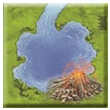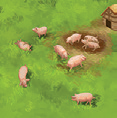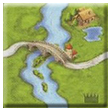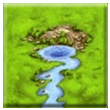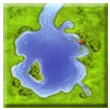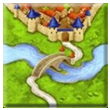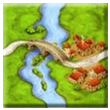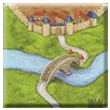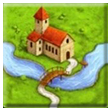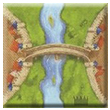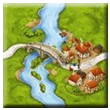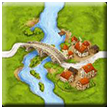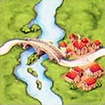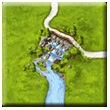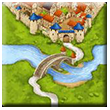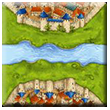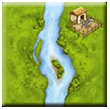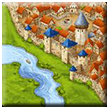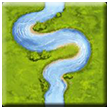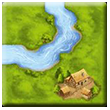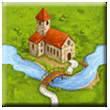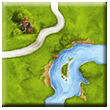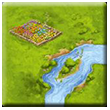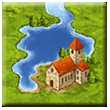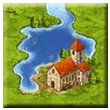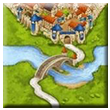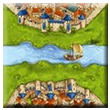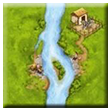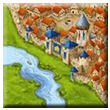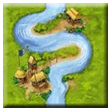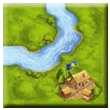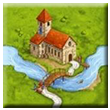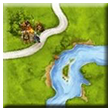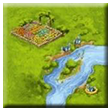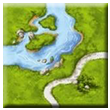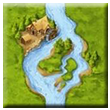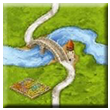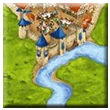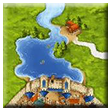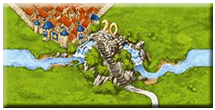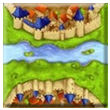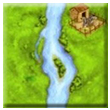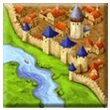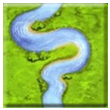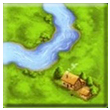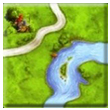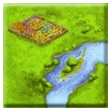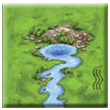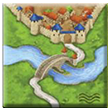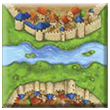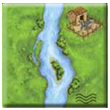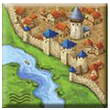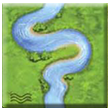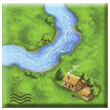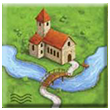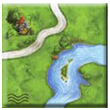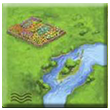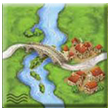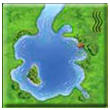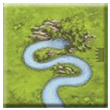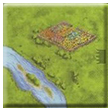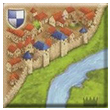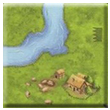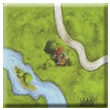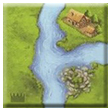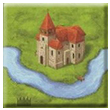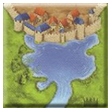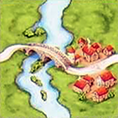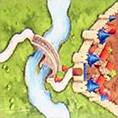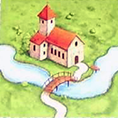Fluss
Allgemeine Informationen und Kommentare
Der Fluss für die neue Edition wurde von Hans im Glück 2014 veröffentlicht. Für die erste Ausgabe wurde der Fluss 2001 veröffentlicht.
The River II was released for the New Edition by Hans im Glück in 2017 as part of Count, King and Robber. The River II was originally released for the 1st. Edition in 2005, and later bundled in the major expansion Count, King and Robber in 2008.
The 20th Anniversary River was released by Hans im Glück in 2021 as part of the 20th Anniversary Edition.
The River C3 was originally released by Hans im Glück in 2021. It is a variation of The River originally released for the New Edition.
CutCassonne, the cut-n-play 10-tile promo from 2014, included 3 river tiles that can added to any river expansion.
Die Flusserweiterung ändert den Spielstart. Vor den normalen Plättchen werden zuerst die Fluss-Plättchen gelegt.
Copies of The River printed in the period 2014-2016 and CutCassonne have the darker city backgrounds. The 20th Anniversary River and The River C3 have cities with clipped buildings.
| Changes to the 20th Anniversary Edition and Carcassonne C3
The rules for the 20th Anniversary Edition and Carcassonne C3 stay the same but the roles of some meeples have been updated:
Publishers have followed the new roles provided in the rules by HiG, although some of these changes are not noticeable in other languages. Note: We stick to the classic role convention for the sake of consistency with all the exisiting rules for the time being. HiG may decide to update the rules in the future to follow this new naming convention for new releases and reprints. |
Für die erste Edition gelten folgende Regeln: Fluss.
Spielmaterial
- Der Fluss: 12 Fluss-Plättchen, jedes mit einer dunklen Rückseite. Die Original-Version hat kein Erweiterunssymbol. Die Version der (Big Box 6 Version), hat einen Wellen Symbol.
- Der Fluss II: 12 Fluss-Plättchen, jedes mit einer dunklen Rückseite und einem Kronen-Symbol
Regeln
Vorbereitung
The river expansions replace the start tile. Select the river expansion you want and discard the others. However, you may combine The River and The River II as indicated below.
Preparation of The River (New Edition and C3)
Der Fluss und der Fluss II ersetzen die Start-Plättchen. Legen Sie die Quell- und See-Plättchen beiseite. Mischen Sie die restlichen Fluss-Plättchen und legen Sie sie mit der Vorderseite nach unten. Füge das See-Plättchen zum Boden des Stapels hinzu und lege das Quell-Plättchen mit der Vorderseite nach oben als Start-Plättchen.
The same rules apply to The River C3, even if its source and lake tiles are slightly different:
Vorbereitung Fluss II
Der Fluss II Graf, König und Konsorten, enthält eine Flussgabelung. Sie sollte zusammen mit den Quell- und See-Plättchen beiseite gelegt werden. Die Flussgabelung wird direkt (nach dem Quell-Plättchen) gelegt.
Combining The River and The River II
You can combine The River from base game with The River II to make a very long river. Keep only one source and one lake.
Preparation of the 20th Anniversary River
Set aside the double-sized source and the two lake tiles. Shuffle the remaining river tiles and stack them facedown. Add the two lake tiles in random order to the bottom of the stack, and place the source tile faceup as the starting tile.
Note: In the game, a double-sized tile, such as this river source, counts as 2 single tiles (for example, for an adjacent monastery). [1]
Spielablauf
Legen eines PlättchensSie ziehen ein Fluss-Plättchen und legen sie so an, dass ihre Kanten mit den Kanten der bereits im Spiel befindlichen Plättchen übereinstimmen. Der Fluss kann sich jedoch nicht zweimal hintereinander in die gleiche Richtung drehen, da dies die Gefahr birgt, dass das nächste Plättchen nicht angelegt werden kann. [2] Die Spieler müssen alle Fluss-Plättchen ziehen und anlegen, bevor sie normale Plättchen ziehen können. Antwort: Only immediate U-turns are explicitly forbidden. Naturally, there can also be problems if a straight river tile lies between. Turning river the same way three times should also be considered prohibited. When playing with The River II or the 20th Anniversary River, you may have up to two river branches to choose from when creating the river. You must always place a river tile on an open end of the river. So you must always extend the river until you have placed the lakes at the open ends. You cannot connect both river branches together. 2.Einsetzen eines MeeplesWie bei jedem anderen Plättchen kannst du deinen Meeple auf jede Strasse, Städte, Kloster, Wiese des gerade angelegten Plättchen, gemäß den Regeln, setzen. [3] Meeple können nicht auf den Fluss selbst gesetzt werden. Wenn du das letzte Fluss-Plättchen (der See mit dem Vulkan) anlegst, kannst du keinen Meeple auf dieses Plättchen setzen. Unmittelbar nach dem anlegen kannst du eine weiteres normales Plättchen ziehen und anlegen.[4] WertungDer Fluss selbst wird nicht gewertet. |
Anmerkung zu Fluss II
Das Wirtshaus und der Vulkan am Fluss folgen den Regeln ihrer Erweiterung (Wirtshäuser und Kathedralen bzw. Burgfräulein und Drache). Der Schweinestall hat die gleiche Wirkung wie ein Schwein auf der Wiese (von Händler und Baumeister). Wenn Sie ohne diese Erweiterungen spielen, ignorieren Sie diese einfach.
The inn and the volcano on the river follow the rules from their expansions (Exp. 1 - Inns and Cathedrals and Exp. 3 - The Princess and the Dragon, respectively). The pig-herd [5] has the same effect as a pig in a field (from Exp. 2 - Traders and Builders). If you are playing without any of these expansions, simply ignore their associated features.
Klarstellungen für neue Plättchen
When placing meeples and scoring fields bear in mind that river segments split fields. [6]
The houses by this bridge do not end the road.
Other expansions
For the River II there are some clarifications when using it with other expansions:
![]() The pig-herd increases the value of its field by 1 point per completed city and castle. This bonus is in addition to the points given by the pig. [7]
The pig-herd increases the value of its field by 1 point per completed city and castle. This bonus is in addition to the points given by the pig. [7]
![]() The pig-herd only affects field scoring for farmers during the game (due to the barn) and after the game. Barns do not score additional points from the pig-herd after the game. [8] [9]
The pig-herd only affects field scoring for farmers during the game (due to the barn) and after the game. Barns do not score additional points from the pig-herd after the game. [8] [9]
![]() Frage: Does the pig-herd tile still score an extra point when there is a barn on the field (barn = 4 points, barn+pig-herd = 5 points per city)?
Frage: Does the pig-herd tile still score an extra point when there is a barn on the field (barn = 4 points, barn+pig-herd = 5 points per city)?
Antwort: The pig-herd tile only counts in connection with farmers, not the barn.
![]() We recommend not to use a river and The Count of Carcassonne. Combining the two can lead to situations where the river cannot be completed.
We recommend not to use a river and The Count of Carcassonne. Combining the two can lead to situations where the river cannot be completed.
- Note: If you decide to use The Count of Carcassonne and a river as starting tiles for a game, it is possible that one will not be able to use all of the river tiles if they are placed too close to the City of Carcassonne. River tiles which cannot be placed should be removed from the game, in accordance with the basic rules. Even if the river cannot be placed in its entirety, the game should proceed in the usual way.[10]
The question of how to combine the various "starting" expansions of Carcassonne is a longstanding one, and HiG has changed its mind several times.
The original rules for The Count of Carcassonne included the following clarification: "If the river is being used, then the source tile should be placed next, and in such a way that the river leads away from the city." Yet the rules still said that it was probably better not to use the expansions together, and this was the only piece of advice to make it into the introductory paragraph of its rules in Exp. 6 - Count, King & Robber for Carcassonne I: “It is not recommended to combine The Count of Carcassonne and The River II, as situations may arise in which it is impossible to place tiles properly."
The Carcassonne I rules by ZMG include the following paragraph: "The river source must begin at one of the corners of the City of Carcassonne. The players should place the river tiles so that the river flows away from the City of Carcassonne so as to avoid placement problems. Again, combining The Count of Carcassonne and The River I or The River II is not recommended."
As indicated above, this is no longer the recommended approach. Instead, one should always remember the rule from the basic game: "In the rare case that a tile cannot be placed anywhere, it is removed from the game, and the player draws another." If the river winds around the City of Carcassonne in such a way that you cannot place the next tile (river or otherwise), the tile should be placed to one side, and another drawn. An interesting corollary of this is that the river does not have to be finished: if it is impossible to do so, you do not have to place the final lake tile, and a permanent gap in the playing field might arise (which could, of course, subsequently be filled by an abbey from Exp. 5 - Abbey & Mayor).
This clearly has consequences beyond combining the two expansions mentioned. Though the rules still say that U-turns are not allowed, resolving such issues is now much more straightforward—no more need to defenestrate players who insist on making awkward tile placements. And it helps considerably in establishing what a game of Mega-Carcassonne should look like.
Of course, some people will object that this rule destroys the aesthetics of the playing field. They might be right, and they are free to adopt a house rule which is more comfortable to them. But for the rules lawyers among us, this rule is an important development.
House rules
House rules for The River
- You are not permitted to lay down any meeples until the entire river is down. (Thanks to metoth)
- Once the river is complete, it may be moved to the center of the playing area. (Thanks to Joff)
- Instead of starting with the spring and setting aside the lake, put all of the river pieces into the bag. In this way the river can be any size and there is usually more then one option for placing a river tile. (Thanks to DavidP)
- Mix the original starting tile (without a river) in with the river tiles. If it is drawn then it acts like a 'bonus' tile that can be placed anywhere. (Thanks to RationalLemming)
- Lay the river in reverse order, from lake to spring. No real advantage, but might be more desirable, when playing the Count of Carcassonne expansion, to have the lake near the City of Carcassonne for purely aesthetic reasons. (Thanks to Scott)
House rules for The River II
- Play the fork of the river first, and lay the spring last. The lakes are mixed in with the other river tiles. (Thanks to Joff)
- Pig-herd tiles do not score a bonus. (Thanks to Joff)
- Play both rivers backwards starting with the city/lake. This is more realistic because you then get two springs producing rivers that join and flow ‘down’ to a lake. Discard two lakes—the plain one from River I and the volcano. To set up, place the lake tile, put one spring tile aside as a final ending tile, and then split the balance of the river tiles into two stacks. The junction tile is shuffled into stack 1 and the other spring into stack 2. Then the stack 1 is placed on stack 2—so that the junction will be drawn sometime before the spring. If playing with the Count of Carcassonne, place the city/lake so that it completes one of the small cities around Carcassonne. (Thanks to dwhitworth)
- Select only one lake tile and use two spring tiles. Lay the river in reverse order. The fork can be placed randomly, or at some predetermined point. The end result is two rivers flowing into one which then flows into a lake. (Thanks to Scott)
- Start from the fork, playing tiles on all three branches. Play the spring and lake tiles at the end, or mix two of the three with the rest of the river before play to have two of the three branches end randomly. (Thanks to Scott)
Plättchen Verteilung
The River I C3
20th Anniversary River
Der Fluss
The River I C2 (Big Box 6 version)
Der Fluss II
CutCassonne C2
Referenzen
Für Lizenzen und Erklärungen besuche Icons page.
- ↑
 This clarification is included in the HiG rules but omitted by ZMG.
This clarification is included in the HiG rules but omitted by ZMG.
- ↑
 Bedeutet das es nie eine Kehrtwende gibt, weil es das Anlegen der nachfolgenden Fluss-Plättchen erschweren wird? Antwort: Nur direkte Kehrtwendungen sind ausdrücklich verboten. Natürlich kann es auch Probleme geben, wenn dazwischen eine gerade Fluss-Plättchen liegt. Es sollte auch als verboten angesehen werden, den Fluss dreimal auf die gleiche Weise zu wenden.
Bedeutet das es nie eine Kehrtwende gibt, weil es das Anlegen der nachfolgenden Fluss-Plättchen erschweren wird? Antwort: Nur direkte Kehrtwendungen sind ausdrücklich verboten. Natürlich kann es auch Probleme geben, wenn dazwischen eine gerade Fluss-Plättchen liegt. Es sollte auch als verboten angesehen werden, den Fluss dreimal auf die gleiche Weise zu wenden.
- ↑
 Beachten Sie, dass der Fluss die Wiesen trennen. (08/2014) Lampertheim
Beachten Sie, dass der Fluss die Wiesen trennen. (08/2014) Lampertheim
- ↑
 Das bedeutet, dass du keine andere Aktion ausführen kannst.
Das bedeutet, dass du keine andere Aktion ausführen kannst.
- ↑
 The English rules called this feature "pigsty." We use pig-herd for consistency with Carcassonne I and also in order to avoid the confusion with the pigsty feature introduced in Carcassonne II, scored by some expansions such as The Markets of Leipzig or The Tollkeepers.
The English rules called this feature "pigsty." We use pig-herd for consistency with Carcassonne I and also in order to avoid the confusion with the pigsty feature introduced in Carcassonne II, scored by some expansions such as The Markets of Leipzig or The Tollkeepers.
- ↑ Cite error: Invalid
<ref>tag; no text was provided for refs namedriver-separate-fields - ↑
 You do receive the bonus from the pig-herd tile even if you don't have a pig on the field. The pig-herd is a neutral pig, so to speak.
You do receive the bonus from the pig-herd tile even if you don't have a pig on the field. The pig-herd is a neutral pig, so to speak.
- ↑
 The pig-herd tile can still score an extra point per city when there is a barn on the field.
The pig-herd tile can still score an extra point per city when there is a barn on the field.
- ↑
 There are no official rules for using two pig-herd tiles, as there are no rules for using two copies of The River II, and the similar GQ11 tile is not officially a pig-herd tile (Games Quarterly #11). However, if one field has multiple pig-herd tiles, it seems that they should not stack; in other words, the bonus should only be awarded once, in keeping with other landscape bonuses such as inns and cathedrals.
There are no official rules for using two pig-herd tiles, as there are no rules for using two copies of The River II, and the similar GQ11 tile is not officially a pig-herd tile (Games Quarterly #11). However, if one field has multiple pig-herd tiles, it seems that they should not stack; in other words, the bonus should only be awarded once, in keeping with other landscape bonuses such as inns and cathedrals.
- ↑
 This is a general version of a paragraph new in the HiG and RGG editions of Big Box 2, and is rather suggestive for a game of Mega-Carcassonne.
This is a general version of a paragraph new in the HiG and RGG editions of Big Box 2, and is rather suggestive for a game of Mega-Carcassonne.









